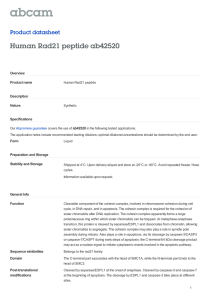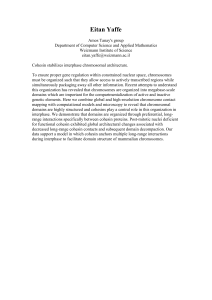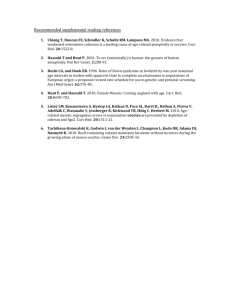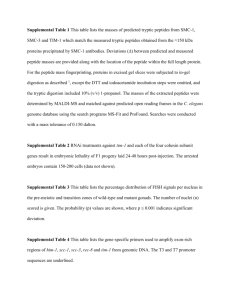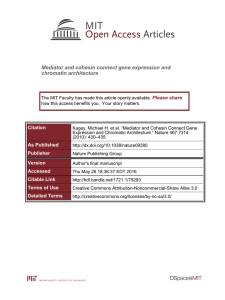Anti-Rad21 antibody (Agarose) ab19205 Product datasheet
advertisement
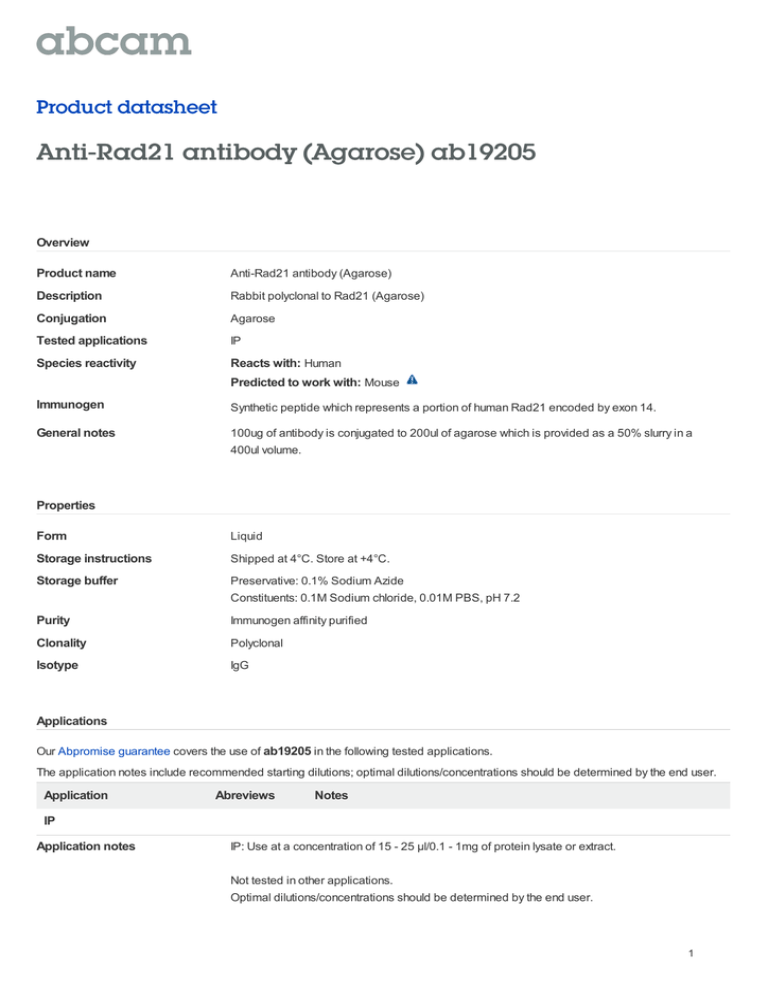
Product datasheet Anti-Rad21 antibody (Agarose) ab19205 Overview Product name Anti-Rad21 antibody (Agarose) Description Rabbit polyclonal to Rad21 (Agarose) Conjugation Agarose Tested applications IP Species reactivity Reacts with: Human Predicted to work with: Mouse Immunogen Synthetic peptide which represents a portion of human Rad21 encoded by exon 14. General notes 100ug of antibody is conjugated to 200ul of agarose which is provided as a 50% slurry in a 400ul volume. Properties Form Liquid Storage instructions Shipped at 4°C. Store at +4°C. Storage buffer Preservative: 0.1% Sodium Azide Constituents: 0.1M Sodium chloride, 0.01M PBS, pH 7.2 Purity Immunogen affinity purified Clonality Polyclonal Isotype IgG Applications Our Abpromise guarantee covers the use of ab19205 in the following tested applications. The application notes include recommended starting dilutions; optimal dilutions/concentrations should be determined by the end user. Application Abreviews Notes IP Application notes IP: Use at a concentration of 15 - 25 µl/0.1 - 1mg of protein lysate or extract. Not tested in other applications. Optimal dilutions/concentrations should be determined by the end user. 1 Target Function Cleavable component of the cohesin complex, involved in chromosome cohesion during cell cycle, in DNA repair, and in apoptosis. The cohesin complex is required for the cohesion of sister chromatids after DNA replication. The cohesin complex apparently forms a large proteinaceous ring within which sister chromatids can be trapped. At metaphase-anaphase transition, this protein is cleaved by separase/ESPL1 and dissociates from chromatin, allowing sister chromatids to segregate. The cohesin complex may also play a role in spindle pole assembly during mitosis. Also plays a role in apoptosis, via its cleavage by caspase-3/CASP3 or caspase-7/CASP7 during early steps of apoptosis: the C-terminal 64 kDa cleavage product may act as a nuclear signal to initiate cytoplasmic events involved in the apoptotic pathway. Sequence similarities Belongs to the rad21 family. Domain The C-terminal part associates with the head of SMC1A, while the N-terminal part binds to the head of SMC3. Post-translational modifications Cleaved by separase/ESPL1 at the onset of anaphase. Cleaved by caspase-3 and caspase-7 at the beginning of apoptosis. The cleavage by ESPL1 and caspase-3 take place at different sites. Phosphorylated; becomes hyperphosphorylated in M phase of cell cycle. The large dissociation of cohesin from chromosome arms during prophase may be partly due to its phosphorylation by PLK. Cellular localization Nucleus. Chromosome. Chromosome > centromere. Associates with chromatin. Before prophase it is scattered along chromosome arms. During prophase, most of cohesin complexes dissociate from chromatin probably because of phosphorylation by PLK, except at centromeres, where cohesin complexes remain. At anaphase, it is cleaved by separase/ESPL1, leading to the dissociation of the complex from chromosomes, allowing chromosome separation. Once cleaved by caspase-3, the C-terminal 64 kDa cleavage product translocates to the cytoplasm, where it may trigger apoptosis. Please note: All products are "FOR RESEARCH USE ONLY AND ARE NOT INTENDED FOR DIAGNOSTIC OR THERAPEUTIC USE" Our Abpromise to you: Quality guaranteed and expert technical support Replacement or refund for products not performing as stated on the datasheet Valid for 12 months from date of delivery Response to your inquiry within 24 hours We provide support in Chinese, English, French, German, Japanese and Spanish Extensive multi-media technical resources to help you We investigate all quality concerns to ensure our products perform to the highest standards If the product does not perform as described on this datasheet, we will offer a refund or replacement. For full details of the Abpromise, please visit http://www.abcam.com/abpromise or contact our technical team. Terms and conditions Guarantee only valid for products bought direct from Abcam or one of our authorized distributors 2
